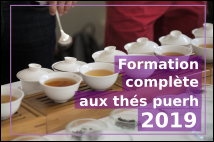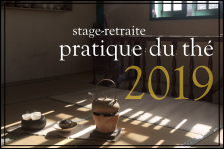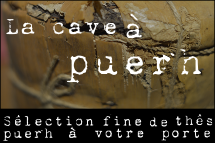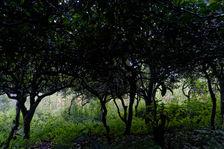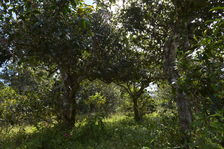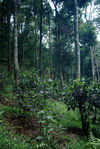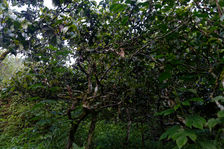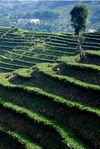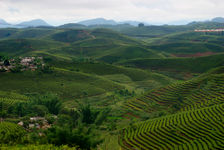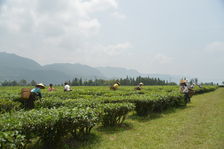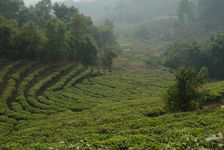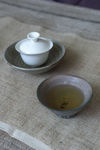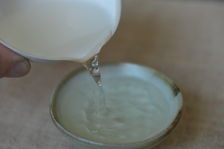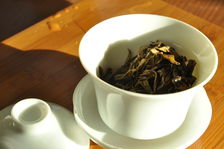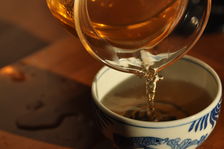 This page is not a real translation but just an automatic translation generated by computer of the original article, written in French language! Its not good... but better than nothing!
This page is not a real translation but just an automatic translation generated by computer of the original article, written in French language! Its not good... but better than nothing!Want to help us do diffuse puerh tea culture in english, by providing a better (or corrected) translation?
Please contact us!

I would like to offer you today a small extension of a study that will interest particularly tea lover who wants to learn more about the benefits of consumption of puerh (Pu Er tea) "Pu-erh tea tasting in Yunnan, China:Correlation of drinkers' perceptions to phytochemistry "( The tasting tea in Yunnan:Correlation between the perception of the tea drinker and Phytochemistry ), published in 2010 by the Journal of Ethnopharmacology .
This study, conducted by Selena Ahmed a, b, c, d, e, * , Uchenna Unachukwu c, f , John Richard Stepp d, g , Charles M. Peters a, d Long Chunlin d, th , Edward Kennelly b, c, d, f , proposes to observe the relationships between:
1.the variables tea production puerh (Pu Er tea) (environment, nature gardens, etc.)
2.la perception of these teas taste and judgment of the amateur
3.la how to brew tea ( gong fu cha , multiple infusions)
4.the photochemical profiles (variety of natural substances produced by the plant) tea, giving in particular antioxidant properties (one of the main benefits of consumption puerh (Pu Er tea) tea on the body) and exciting (caffeine).
Or to simplify:
how the production conditions puerh (Pu Er tea) teas, for example between those from gardens ancient or production terrace have or not influence of a hand on the gustatory judgment of the drinker and secondly on benefits Potential tea.
In what then there or not link between, on the one hand, the gustatory judgment of the driven amateur and on the other hand, the Origin real tea leaves (ecological garden, intensive plantation) and finally the benefits of their consumption.
Finally, how the how tea is brewed will also have an influence on these properties.
This raises many questions for the amateur or the one who discovers the puerh (Pu Er tea) teas:
what are the most beneficial puerh (Pu Er tea) teas for health? What is the difference between the properties of raw puerh (Pu Er tea) (green) and fermented (brown)?
Can gustatorily make the difference between a tea old trees or ecological garden (very sought) and a tea from terrace cultivation? Are teas from natural environments and truly as is commonly said, the best in the palace?
The best teas gustatorily they are also the best for you?
Teas of natural or ancient gardens, sought amateurs and much more expensive than the production deck, are they also better for your health (in terms of their antioxidant action at least) compared to puerh (Pu Er tea) from plantations Terrace?
What is the best way to infuse the puerh (Pu Er tea) teas to make the most of their wealth and taste maximize their benefits?
Starting Points
Set a puerh (Pu Er tea) tea and great diversity within this family teas
tea definition puerh (Pu Er tea) is controversial, it is well to remember which reach it by tea puerh (Pu Er tea) The authors of this study. Puerh tea is made by these researchers as a tea made from Camellia Sinensis var. Assamica (large-leaf tea tree) such as is found in the Yunnan and border regions ( Laos, Vietnam, Myanmar and India ), which sheets can be transformed in different ways, whether or not involving a fermentation of the latter.




- 1.Tea Tree with large leaves in Yunnan
- 2.large leaves Tea Tree Laos
- 3.Tea production puerh (Pu Er tea) Myanmar
- 4.Leaves of Camellia Sinensis Assamica in Yunnan
So close to a definition of that which is commonly seen in Yunnan since the late 90s in particular Article recalls that different socio-linguistic groups such as Bulang, the Wa and Akha have used these sheets in various ways (including eaten) for centuries (although the sheet processing modes, fermentation and so consume tea could then well be different).
Yet there are large differences within the teas included in this definition. First, different production processes (see From the tree to the cake), lead to radically different teas although all appointed puerh:
Raw puerh (Pu Er tea) or Green on the one hand, are in production of teas unfermented little or fermented so that similar to green teas (and could well be classified as such).



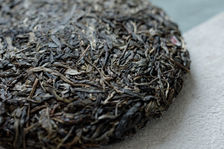
- 1.freshly harvested tea leaves puerh
- 2.Gross puerh (Pu Er tea) Processing
- 3.Puerh green after drying
- 4.Slab of raw puerh
Under the action of the oxidation natural and fermentation due to microorganisms living on the surface of leaves, these teas evolve over time, composition, their color and their aromas transform year after year to create a tea post-fermented dark.
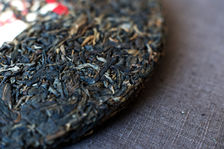
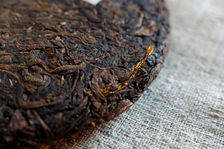
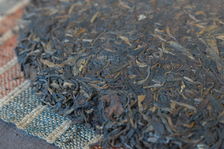
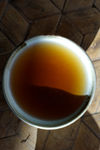
- 1.Tea puerh (Pu Er tea) after 10 years of maturation
- 2.puerh tea after 15 years of maturation
- 3.puerh tea after 20 years of maturation
- 4.Liqueur of an old puerh
Inspired by this phenomenon of natural fermentation, have been developed various methods artificial fermentation or controlled the puerh (Pu Er tea) tea, leading to a new form of puerh (Pu Er tea) tea, black and often strongly fermented whose color and flavor are different from other forms of puerh (Pu Er tea) teas.
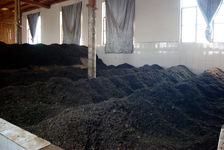

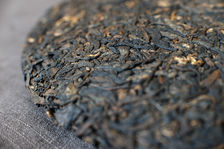
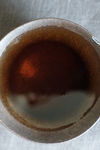
- 1.artificial fermentation puerh (Pu Er tea) tea in Yunnan
- 2.Refining puerh (Pu Er tea) tea in Hong Kong
- 3.Puerh artificially fermented
- 4.Liqueur fermented puerh
But that's not all. There are also major differences in the conditions of production of fresh leaves, which can be derived both from forest (where we find both wild tea trees and tea trees old plantations) of < b> agricultural forests also called old tea gardens which are small patches of forests where the gardens were established in retaining some biodiversity, Mixed cultures or finally intensive monocultures terraces ( Tai Di Cha ).
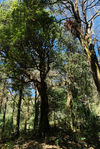
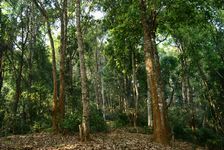
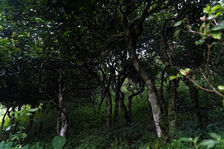
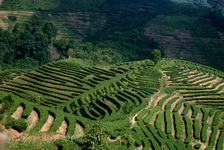
- 1. Wild Tea Garden in the heart of the forest
- 2.Garden for tea in the forest
- 3.former Garden for tea
- 4.Tea Plantations deck
These differences in the origin of leaves and transformation they undergo obviously have a great influence on the composition of these teas. But this variety of teas puerh (Pu Er tea) is however very often or almost always omitted from various studies that I could see on the properties of puerh (Pu Er tea) teas, making conclusions difficult to reuse or recent applicable beyond the samples examined.
In fact, what the findings of a study that would cover, for example, a green tea from old trees, rich and plucked a low yield, could be applied for example to a black puerh, fully fermented tea product from bushes from intensive farming?
I am thinking of all those puerh (Pu Er tea) sold as "eat-fat" miracles, generally based on the lowest fermented puerh (Pu Er tea) end of the market, whose composition is probably away greatly from those used in the research cited by vendors to "justify" diet properties of their products.
To reflect this diversity, the authors of this study was therefore examined ten different samples of puerh (Pu Er tea) teas. Half of the samples were from agricultural forests , while the other half came from Terrace plantations . Three teas were young raw puerh (Pu Er tea) four older puerh (Pu Er tea) (10 years), and three of the fermented puerh (Pu Er tea) ( shu cha ).
We note in passing, which is a pity, if the approach is exemplary, sampling is against a bit light , with a total of only ten teas finally six categories of puerh (Pu Er tea) ( two types of cultivation methods and three types of maturation) which necessarily creates connections between origin teas and type of maturation. It would be better to cover such a large range of different situations (two types of gardens and three mode maturation already making twelve combinations!) To use a higher number of samples.
The beneficial compounds teas puerh (Pu Er tea)
To assess the medicinal properties of tea puerh, the authors have studied the contents of three important compounds generally about the benefits put forward puerh (Pu Er tea) teas, as measured by HPLC ( chromatography, high performance liquid chromatography ) and the ability to neutralize free radicals (DPPH content).
First was observed content catechin which is the main element usually highlighted on the benefits of non-fermented teas (such as Raw puerh (Pu Er tea) and green teas ). Then observed the compounds resulting from oxidation of these catechins such as methylxanthine (which is found in black teas) responsible for the stimulatory effect of tea ( caffeine ) and statin compounds produced by microbial fermentation of certain teas like puerh (Pu Er tea) teas (and to which is assigned cholesterol-lowering properties). Finally was observed the antioxidant potential of tea through the ability to neutralize free radicals .
The compositions of tea and the combination of these elements will naturally have an influence on the properties of tea for health, but also on color and taste perception tea (bitterness, astringency, softness, etc.), resulting in probable relationship between the perception of the amateur and compounds tea, by extension its health properties.
Very interesting point to finish the study Itss based compounds present in the infusion of the leaves with infusion parameters reflecting the practice of lovers puerh (Pu Er tea) ( tea 8g to 80ml of water, 20 seconds infusion at 95 degrees and successive infusions) and not as has often been the case directly to the compounds found in the leaves, or extracted using methods that have no compared with the reality of tea consumption.
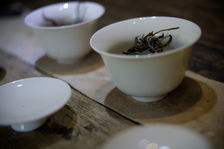
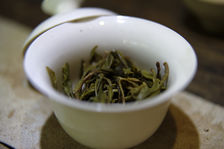

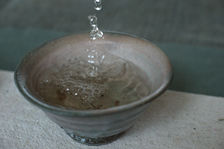
- 1.Short and repeated infusions inspired gong fu cha
- 2.Short and repeated infusions inspired fu cha gong
- 4.Short and repeated infusions inspired the gong fu cha
In this sense, the conclusions of this work are directly applicable to the tea amateur and consumption of tea, where other work (on the composition dry leaves or extraction using alcohol or solvents) have meaning only within a laboratory or a pharmaceutical type of application.
Infusion and taste perception teas puerh (Pu Er tea)
The infusion teas inspired by the gong fu cha has recently revived in Yunnan and is generally perceived as the way to release optimum flavors, tastes, colors and physiological properties of the teas. The study is also considered the influence of this way of infusing teas both on taste perception of these teas and consequences for the organization.
In order to understand and evaluate the taste perception of puerh (Pu Er tea) in Yunnan, the authors of the study we conducted semi-structured interview of a hundred people. Among these producers from different regions of Yunnan (Xishuangbanna, Honghe and Lincang), from different ethnic groups (Bulang, Ahka, Yao, Lahu and Yi), but also vendors, amateurs and experts from rural and urban areas.
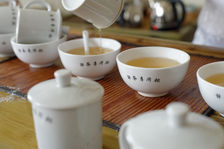
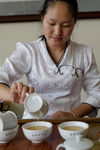
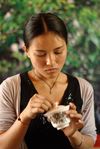
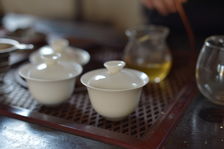
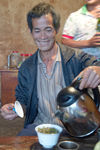
- 1.Example of tea tasting in Yunnan
- 3.Tea Tasting Sample in Yunnan
- 4.Tea Tasting Sample in Yunnan
- 5.Tea tasting in Yunnan Example
Five experts were chosen from these participants to compare ten successive infusions each of the ten samples puerh (Pu Er tea) teas (a total of one hundred infusions) and share their perceptions of their quality of taste, color, origin (former garden, terrace cultivation) but also the supposed medicinal properties of different teas.
Results
Perception and judgment of taste
The authors have studied the words of lovers puerh (Pu Er tea) in Yunnan taste to judge the quality of teas. Of the twenty most used words, the bitterness , followed by a bitter sweet aftertaste ( hui gan ) and smooth led the way. For three quarters of the fans, the bitterness or bitterness followed by sweet aftertaste ( hui gan ) were seen as signs that tea was grown in an environment ecological and natural and indicate tea medicinal properties .
Urban amateurs usually referred to these teas by the words Gu Shu (old trees), Da Shu ( large trees), Tai Sheng (ecological) or Ku Cha (bitter tea).
Besides the nature of the original gardens, fans have raised many parameters relating to the environment and influencing the taste of tea, such as the period of harvest, the season, the soil, the size of the tree or age.
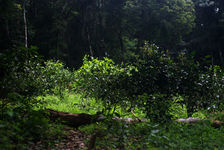
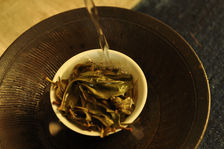

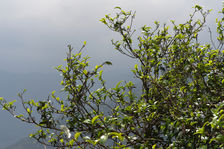
- 1.Tea Garden in an agricultural forest
- 2.Puerh old tea bushes in a Gaiwan
- 3.Infusion of the puerh (Pu Er tea) tea
- 4.Old tea plants
All five experts who participated in this experiment were able to discern by tasting teas from agricultural forests (ancient tea gardens) and those from terrace cultivation , with the first specific bitterness. It is these teas, unfermented from natural environment that have been rated, but were also considered by fans as having the most Medicinal Properties and stimulating effects .
fermented puerh (Pu Er tea) for their part summers deemed means in taste and considered by tasters as having fewer medicinal properties and stimulating effects.
Ten successive infusions are infusions between 4th and 7th which were found to be the most intense.
If this already highlights a trained palate is able to discern the quality of the environment which the tea comes (old gardens, terrace cultivation, etc.), now see if it fits the beneficial compounds teas and if tasting can predict the antioxidant tea and its effect stimulating ?
Properties teas
The authors of the article began by observing the rate of catechins and methylxanthines (caffeine and other) different teas, compounds responsible for antioxidant for the first (catechins) and exciting for the latter (methylxanthine, so caffeine).
The results show first of all very large differences between different teas, some samples with catechins ratio (antioxidant) near 200 times higher to others. The methylxanthine rate (stimulant) vary them doubled according to samples!. This already shows great diversity teas puerh (Pu Er tea) about their properties antioxidant and exciting . Puerh teas are not, as is done too often to be taken as a continuum assumption, but can have very different properties depending on their origin:some may have more pronounced antioxidant properties than others, some may have a stimulating effect (caffeine) more important than others.
The most significant antioxidant has been found in greater amounts in a sample of Gross young puerh (Pu Er tea) from a farming forest . The biggest methylxanthine rate (stimulant) for his part was found in a sample of crude puerh (Pu Er tea) ten years old , fermented naturally (natural storage) and from Terrace planting .
On average, samples from agricultural forests show greater antioxidant levels that samples from terrace cultivation.
Conversely, samples from terrace cultivation have shown an average rate of methylxanthine ( stimulating ) than those from farm forests.
This would tend to show that average puerh (Pu Er tea) from agricultural forests would have more antioxidant properties and fewer stimulant (caffeine) than from terrace cultivation .
If this is the conclusion, already interesting that the authors have chosen, careful observation of the collected data shows, however, other realities that Article does not speak and which are no less interesting!
The authors' conclusions are based in fact on the average levels of catechins and methylxanthines each of the ten infusions of each sample (either infusions percent in total). Then observed the means significantly higher antioxidant levels of for agricultural forest from teas and higher rates of stimulants for teas from terrace cultivation.
But observation Single of each sample also says a lot. For antioxidants, it shows great diversity infusions from agricultural forests (thus with very high rates for some, but very low rates and many other intermediaries) . In front of them, infusions from terrace gardens all show very low antioxidant levels , virtually none of them not exceeding the average value of infusions from agricultural forest!
We conclude that whatever the samples analyzed and infusions, the antioxidant levels appear still very low for teas from terrace cultivation , while the situation is very varied in the For agricultural forest teas from with teas and infusions which have very high antioxidant content, but also many others that do not exceed those from terrace cultivation.
Exactly include the same phenomenon in a reverse manner on the methylxanthine rate ( stimulating ), with rates varied in terms of < b> terrace cultivation and instead always very low rates for teas from agricultural forests (almost exclusively below the average rate met for crops Terrace).
This suggests that the teas brewed from agricultural forest leaves much would all the weak stimulant effects, while those from terraced gardens as the case may be weakly or strongly stimulants.
Conversely, these tea infusions from agricultural forests can have very different antioxidant levels, where they remain generally low for teas from terrace cultivation.
The study then examined the influence of transformation, or maturing tea between a crude puerh (Pu Er tea) (green) unfermented, a puerh (Pu Er tea) fermented artificially ( cha shu ) and naturally aged puerh (Pu Er tea) . She would show antioxidant content (catechins) higher in Green puerh (Pu Er tea) (gross), followed by naturally aged puerh (Pu Er tea) and finally fermented puerh (Pu Er tea) ( cha shu ). The content of stimulants (methylxanthine /caffeine) it would be higher in the older puerh (Pu Er tea) , followed by green young puerh (Pu Er tea) (gross) and finally fermented puerh.
Ratio of judgment and taste properties of teas
Turning to the central point of this work:the ratio of the judgment of taste and composition of teas. When comparing the one hand the feedback from tasters taste and also analyzes what's in the cups, there is a clear connection between the gustatory judgment on the quality of teas and properties of these teas , in particular in terms of the levels of catechins and methylxanthine . Indeed, the top rated infusions and with best eating quality are found to be those with catechins rates and methylxanthine higher or teas that had the most properties antioxidant and exciting . These gustatory judgment does not match against the measure by capacity to neutralize free radicals, the most powerful teas that view being those having been tried means.
At the felt now it is interesting to note that the teas with the highest antioxidant levels have not only been perceived by tasters as gustatorily richest , but also as those estimated by the tasters as most healthy and natural environments from . By cons, and it is also very interesting, it does not was observed relationship between the teas that most appeared stimulants and those actually possessing the highest rates methylxanthine ( caffeine and other ), which show that you can not judge by tasting the stimulating effect of tea puerh (Pu Er tea) .
Less obvious that the gustatory judgment, were also highlighted the relationship between the properties of teas and judgment of the color of liquor, particularly in terms of the content of methylxanthine and the ability to neutralize free radicals ( not for the content of catechins ).
Influence of Infusion Mode
Equally interesting work, studying the content of different compounds each infusion at a tasting inspired like gong fu cha , allows to have an idea of influence of how to brew the tea on of these properties, Health and ability gong fu cha extract the beneficial compounds of puerh (Pu Er tea) teas.
As lovers puerh (Pu Er tea) well know, not only a good raw puerh (Pu Er tea) tea (green) can infuse a large number of successive times (often more than ten), but above all its flavor character evolve as and infusions, Best infusions generally not being the first (as is the case with many other teas) but often the 4th or 5th infusions.
It's no surprise what came out tastings organized for this analysis and in which the brew considered the best, most intensive but also reflecting the eyes of fans more beneficial properties health were consistently 5 infusion. Specifically was observed a gradual increase in the rating of quality of infusions of the 1st to 5th, then a gradual descent of this notation for subsequent infusions.
Where the thing becomes more interesting still is when taste these judgments are related with the properties antioxidant (catechins levels and ability to neutralize free radicals) and substances stimulating (methylxanthine) contained in the cups. Indeed, we observe that the 5th infusion of these teas, recognized during the tasting as better and estimated as the richest in beneficial substances proved well be brewing with the highest rate of catechins and methylxanthine and the greater ability to neutralize free radicals . More generally, we note that more infusions were rated positively, the more they have proven to be rich in antioxidants and stimulating compounds , where the infusions noted weaker were found to contain less of these substances.
In general, there is efficiency brief and successive infusions in the progressive extraction of tea compounds, relative to longer infusions. Moreover, we note in this study that even the 10th infusion still contained notable amounts of the various target compounds and it would have been possible to continue for a number of infusions.
Conclusions, as learned from this study for a tea lover?
Here are brief so the main conclusions that the tea lover can learn from this study:
Puerh teas are not all equal in their benefits:there is a great diversity with regard to anti-oxidant and stimulating properties of puerh (Pu Er tea) teas according to their origin (terrace cultivation, old gardens) or their preparation mode ( puerh (Pu Er tea) green, old puerh, fermented puerh).
Consistent with previous studies, gross puerh (Pu Er tea) (green) show better antioxidant potential compared to artificially aged or fermented puerh. Next is older and finally fermented puerh (Pu Er tea) puerh artificially.
The origin of tea, whether in gardens agricultural forest, ecological garden or terrace cultivation also influences the compounds tea and their antioxidant and stimulating properties:
Teas from agricultural or forest green gardens show on average much better antioxidant capacity and teas from terrace cultivation.
Tea from terraced crops on average show more stimulatory effects (caffeine) that the teas from natural environments.
Teas from natural environments (old gardens) showed varied levels of antioxidant (some teas may have great antioxidant properties, some not), but all low caffeine content.
Conversely, teas from terrace cultivation showed varied levels of caffeine (some may be very challenging, some not) all but very low antioxidant levels.
Bitterness and hui gan (soft return) are signs of the quality of the environment in which the tea comes and beneficial properties of tea:puerh teas perceived as bitter, or bitter monitored smooth ( hui gan ) is judged by the tasters summers in Yunnan as containing more beneficial substances and have actually shown higher levels of antioxidant.
It has by cons not found relationship between the teas perceived as more or less stimulating and beneficial teas caffeine content, stimulating impression of tea when tasting and pretend to be an illusion.
gong fu cha , or simply the brief and successive infusion tea appears to be a particularly effective way of exploiting the benefits of tea puerh (Pu Er tea) gradually extracting different compounds tea.
It is noted further that the 10th of each infusion tea, even when the taste seemed slightly, still contained beneficial compounds. It is therefore recommended to those who seek in tea consumption puerh (Pu Er tea) their benefits, their teas to infuse more than ten times and even if the flavors seem so light.
a Institute of Economic Botany, The New York Botanical Garden, Bronx, NY 10458, USA
b
Department of Biology, The Graduate Center, City University of New York, 365 Fifth Avenue, NY 10016, USA
c
Department of Biological Sciences, Lehman College, Bronx, NY 10468, USA
d
School of Life and Environmental Science, Central University for Nationalities, Minzu University, Zhong-Guan-27 Cun South Avenue, Beijing, China
th
Kunming Institute of Botany, Chinese Academy of Sciences, Heilongtan, Kunming, Yunnan, China
f
Department of Biochemistry, The Graduate Center, City University of New York, 365 Fifth Avenue, NY 10016, USA
g Department of Anthropology, University of Florida, 1112 Turlington Hall Gainesville, FL 32611, USA

